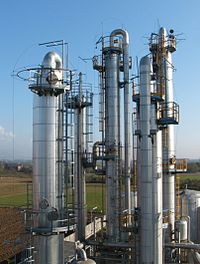
Photo from wikipedia
The aim of this study is to compare the controllability properties of conventional distillation sequences and dividing-wall columns with upper and lower partitions (DWCs). The controllability analysis methodology uses the… Click to show full abstract
The aim of this study is to compare the controllability properties of conventional distillation sequences and dividing-wall columns with upper and lower partitions (DWCs). The controllability analysis methodology uses the Control Design Interface (CDI) module of Aspen Dynamics to obtain the state space representation of the studied systems. The frequency dependent controllability indices are calculated by Matlab on the basis of the matrices of the transferred state space representation. The study includes the examination of the conventional direct and indirect sequences and two DWCs systematically generated from the corresponding conventional sequences. Case studies are completed using ternary alcohol mixtures with different eases of separation. Results show that conventional distillation sequences have more favorable controllability properties than those of the DWCs if direct separation and mixtures with symmetrical ease of separation are considered. In the cases of mixtures with nonsymmetrical ease of s...
Journal Title: Industrial & Engineering Chemistry Research
Year Published: 2017
Link to full text (if available)
Share on Social Media: Sign Up to like & get
recommendations!